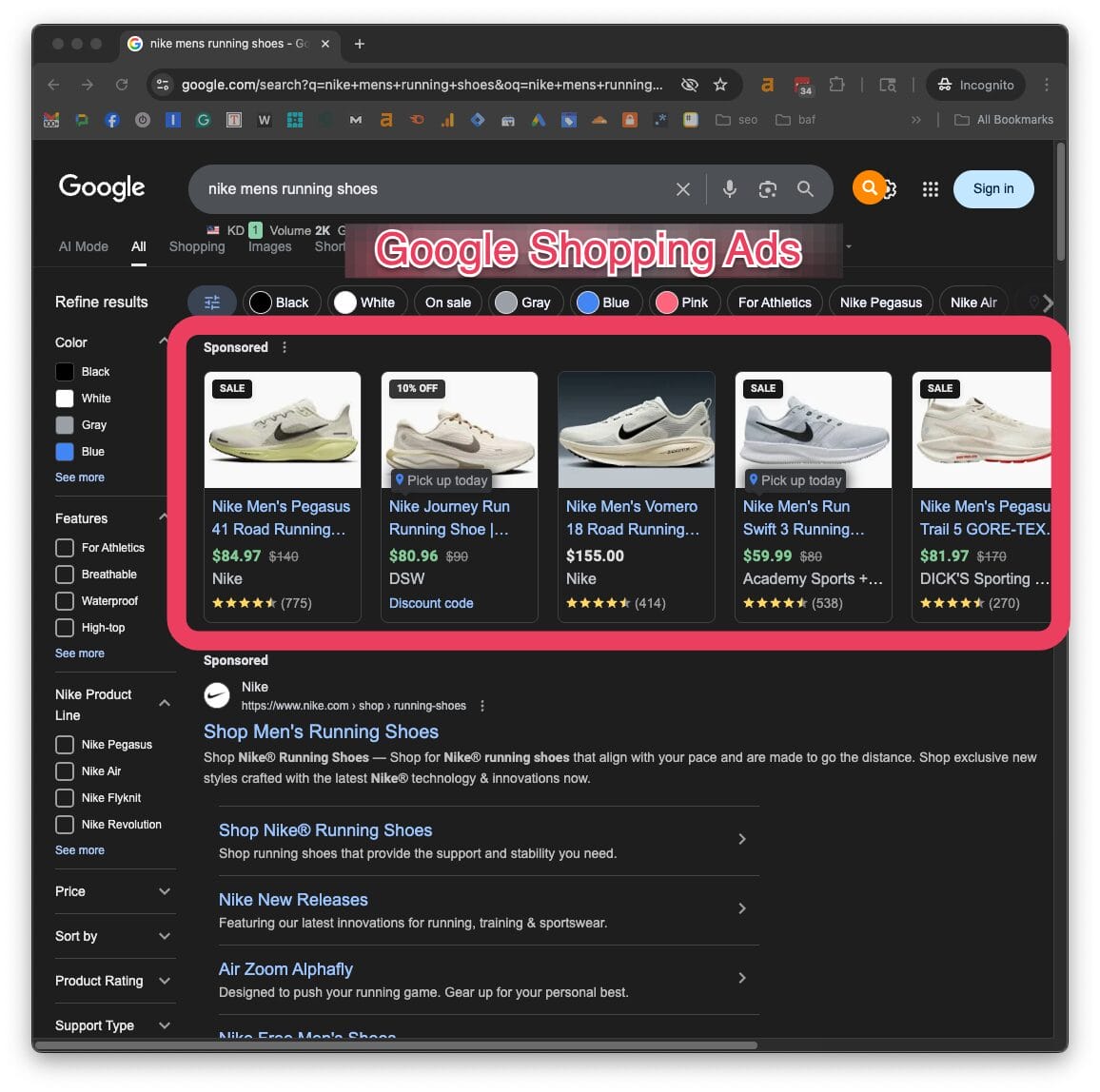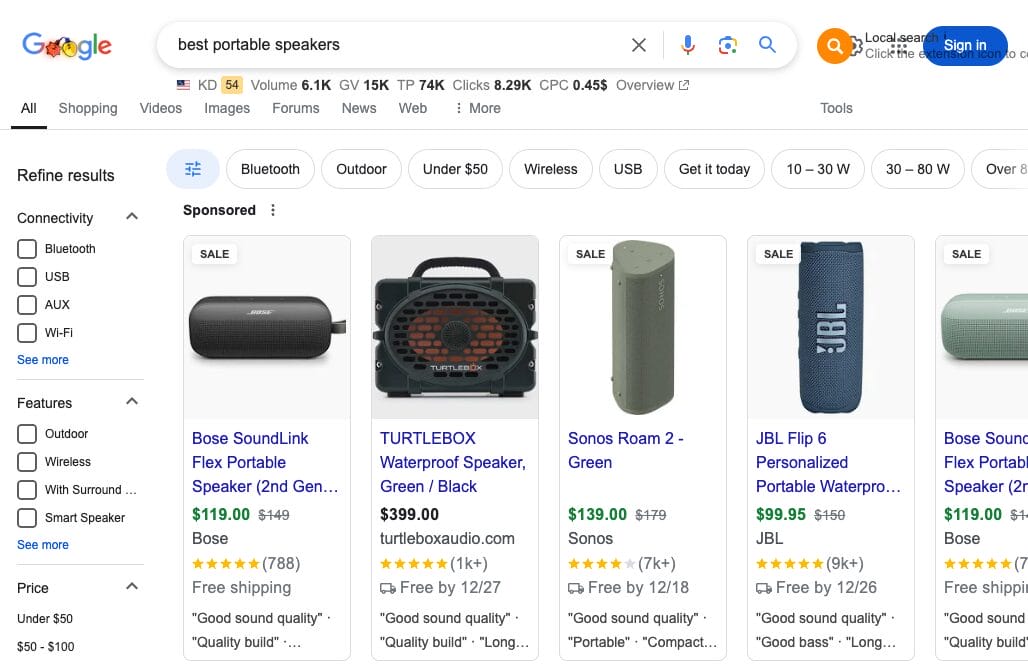Updated on July 22, 2025
Google Shopping Ads are a key tool for e-commerce businesses to highlight their products and drive sales. These visually rich ads appear at the top of Google search results and across Google’s platforms, featuring product images, prices, and store details.

They attract high-intent shoppers who are actively searching for products to buy, making them one of the most efficient ad formats for generating revenue.
Proper Setup and Management are Key
When set up and managed effectively, Google Shopping Ads can yield a remarkable 3-15x return on ad spend (ROAS). For instance, a $1,000 ad investment with a 5x ROAS could generate $5,000 in gross revenue. This consistent potential for strong performance makes Shopping Ads a cornerstone for many e-commerce businesses.
Google Shopping Ads capture product details from a business’s product feed (generated by many popular e-commerce platforms), including images, prices, descriptions, and availability.
For instance, searching for “best portable speakers” will show products with prices, images, and links directly on the results page (example below). Shoppers can instantly compare options, making their buying decisions faster and easier.

Shopping ads are a cornerstone of e-commerce advertising because they meet consumers at the point of purchase intent.
Why Google Shopping Ads Work
1. Shoppers Ready to Buy
Shopping ads regularly deliver significant returns for businesses because they target shoppers ready to buy. Because of this, they often have a high Return On Ad Spend (ROAS). For example:
- A fashion retailer spending $2,000 on Shopping Ads might generate $10,000 in sales if they achieve a 5x ROAS.
- A specialty cookware store could invest $1,000 and see a 7x return, pulling in $7,000 in revenue from specific product searches like “ceramic non-stick frying pan.”
This high ROAS happens because Shopping Ads focus on high-intent buyers rather than casual browsers.
2. Visual and Informative Format
People shop with their eyes. Shopping Ads display your product images, prices, and store information upfront. This allows shoppers to:
- Compare products before clicking.
- Make informed decisions, reducing wasted ad spend.
For example, seeing the price upfront helps filter out buyers outside your target price range, saving you money by reducing irrelevant clicks.
3. Cost-Effective Marketing
Shopping Ads often have lower cost-per-click (CPC) rates than text ads while delivering higher conversion rates. That means your budget stretches further, driving more revenue for every dollar spent.
The Role of Performance Max Campaigns
Google’s Performance Max campaigns are an all-in-one advertising solution. They use machine learning to optimize ads across platforms like Search, Display, and YouTube. Performance Max includes Shopping Ads as part of its strategy, but doesn’t emphasize them.
Here’s why running a dedicated Shopping campaign alongside Performance Max is a smart move:
- With focused Shopping Campaigns, you can control bids, budgets, and targeting specifically for your product ads. This level of control empowers you to tailor your strategy to your unique business needs, ensuring your ads work for you. Shopping ads are also tailored toward new customers. In contrast, Performance Max can focus more on remarketing or strategies to convert people who’ve already visited your site or interacted with your brand.
- Performance Max Campaigns: Broaden your reach to build brand awareness and engage audiences across multiple Google platforms.
For example, a furniture store might use a Performance Max campaign to promote their brand and a Shopping campaign to focus specifically on their best-selling chairs.
Why You Can’t Rely on a Single Channel
It’s important to remember that the digital landscape is constantly evolving. Google’s AI-powered tools, such as Search Generative Experience (or AI-powered search), are already changing how search results are displayed.
AI-powered responses reduce the impact of the 10 organic search results, and as this technology evolves, businesses must adapt.
This makes diversification key. Relying solely on organic traffic, social media, or any single marketing channel can leave your business vulnerable to sudden changes. For example:
- Facebook Algorithm Changes: Many businesses that relied heavily on Facebook ads saw performance plummet when algorithm updates prioritized user content over business pages or ads.
- Google Algorithm Updates: Google’s algorithm updates drastically affect search engine rankings, leading to massive traffic changes when a business ranks well and becomes dependent on organic traffic.
By diversifying your efforts across multiple channels, like Shopping Ads, Performance Max, email marketing, and social media, you reduce the risk of being overly reliant on any single channel. Diversification ensures consistent sales even if one channel changes its rules or priorities.
Managing Google Shopping Ads effectively helps businesses maximize their return on investment (ROI). While Google Ads automates many tasks, experienced consultants or agencies have valuable insights and will make adjustments based on what’s working for your business.
Google Ads Management Tasks
- Product Segmentation: Separating high-performing products into their own campaigns allows for tailored bidding and strategy. For example, an agency might isolate a $50 fitness tracker with a high ROAS, focusing more budget and ad placements on it. Leaving a standout product(s) that consistently perform above average in a campaign with other products that don’t perform as well gives you less control and ability to maximize exposure for the standout product(s).
- Adjusting Bids for Low Performers: Underperforming products can still gain exposure, but with reduced bid aggressiveness, which helps balance overall performance and maximize profitability. You do want a space to introduce new products and give them time to get exposure. In a typical Google Shopping or Performance Max campaign set up, your new or underperforming products may never get a fair chance to see if they’ll get results.
- Feed Optimization: An experienced Google Ads agency will optimize product titles, descriptions, and images for search relevance and conversion. They might do this by working with your business or using a feed or inventory management tool. Often, these improvements to your feed and product information will benefit you across marketplaces or channels.
This level of hands-on management is why many businesses work with an experienced Google Ads Management agency to get better results.
Why Google Shopping Ads Matter
Google Shopping Ads are a powerful way to generate revenue. They provide good visibility and targeting, making them an effective marketing tool. However, as search technology changes with AI tools and algorithms, businesses must diversify their marketing strategies to stay stable and grow.
Combining Google Shopping Ads with Performance Max campaigns, email marketing, and other strategies helps create a plan that can adjust to changes in the digital environment.
If you’re ready to scale your e-commerce business and maximize Google Ads performance, contact Garrett Digital today.